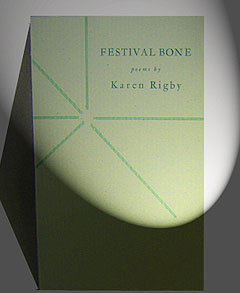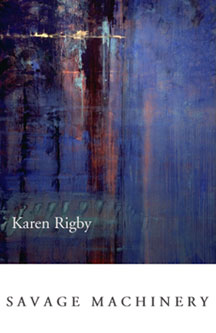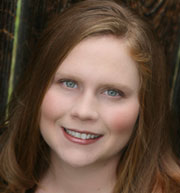RITING POETRY
to share with the world is a challenge, and getting those poems into print can seem like a daunting task. A published poet, like Karen Rigby, author of the chapbooks Savage Machinery and Festival Bone, appreciates that getting poetry published in a journal, magazine, or a chapbook, is a long road with potential thrills at end. Karen Rigby knows from experience the work it takes to bring a poem from pen and paper to published piece.
In 2007, Karen was a recipient of a National Endowment for the Arts fellowship. Two of Karen’s poems were published in O Taste and See: Food Poems (Adastra Press, 2005). Her poetry has also appeared in several journals including Field, New England Review, and Beloit Poetry Journal.
Karen spoke with WOW! and offers a spin on writing poetry that is just as practical as it is encouraging. No, she doesn’t provide a mythical, three-step formula for building a nest egg by writing poetry, but she does present practical, doable advice for writers who want to write poetry—whether or not it pays in fame or fortune.
***
WOW: Karen, you've been awarded several fellowships including the 2007 Literature Fellowship from the National Endowment of the Arts for which you received $20,000 to write! That's a dream come true, and quite an honor. In your opinion, what are some keys to making your application stand out from the others?
Karen: The standard is always to read the guidelines thoroughly—to find out who is eligible for a grant, when the deadline is, what materials need to be included with the application, how it should be sent, and so on.
The road to a fellowship often begins much earlier—by publishing in journals. Once the basic criteria has been met, it’d be hard to say what would make an application stand out.
The panel of judges changes, and can often remain anonymous until after the results are announced. I would never advise trying to “tailor” poems to fit a certain style, since it’d be nearly impossible to guess what the panel’s preferences may be. It’s much more important to write like yourself, anyway.
As an aside, many states have an arts commission or board that offers individual grants to writers—that would also be something to research.
“The road to a fellowship often begins much earlier—by publishing in journals.”
WOW: Another fellowship you received was a residency at the Vermont Studio Center in 2006. What was the experience like for you, and what did you accomplish while you were there?
On Fellowship Guidelines:
To use the NEA literature fellowships as an example, here are the minimum eligibility requirements to apply for a poetry fellowship:
- A volume of 48 or more pages of poetry; or
- Twenty or more different poems or pages of poetry in five or more literary journals, anthologies, or publications which regularly include poetry as a portion of their format.
- Up to 16 poems may be in a single volume of poetry of fewer than 48 pages. This volume, however, may count as only one of the required five places of publication.
Information obtained from the NEA’s eligibility webpage.
Karen: The benefit of a residency—apart from the boost in morale knowing that someone thought the poems stood out—is having the opportunity for contemplation. Often, writing becomes something you do after you’ve finished something else (like work). When you’re at a residency, it’s just you, with hours to spend. That amount of mental solitude can be daunting.
It took a few days to get used to that idea, of having permission to write, but after that, I ended up writing some of the poems that are now in the chapbook. I didn’t set a certain number of poems for myself that I had to finish. Instead of thinking, “I’ve been given this gift; I need to accomplish something quantifiable with it,” I thought of the residency as part of a longer continuum. It didn’t have to result in a project—whatever seed ideas formed then might still manifest later in new work.
WOW: Let’s discuss your poetry writing process for a bit. Do you write your poems in a stream-of-consciousness fashion and rewrite later, or do you labor over each line before moving on to the next?
Karen: Most of my poems have been labored over. I’ve heard the advice to get the first draft out and then revise afterward, but I tend to revise as I go, line by line. It’s like un-combing a knot, teasing the rest of the poem out of the lines that have come right before the one I’m working on.
“Often, writing becomes something you do after you’ve finished something else (like work).”
WOW: That sounds like it takes a great deal of patience as a writer. Do you do much editing after your poem is written?
Karen: Sometimes I do—I’ve had some poems that took twenty drafts. I think I used to drive some of my teachers a little crazy by always being that student who had one more revision for them to comment on, even after the class was already over.
To get an ear for what writing earns a National Endowment for the Arts Literature Fellowship, check out the work of previous winners at the NEA’s Writer’s Corner.
Other times, the poem is nearly done after I’ve written it, but only because I’ve written it, as I mentioned, line by line over a long period of time. That self-awareness about what’s working and what isn’t goes a long way. It’s a combination of instinct, practice, craft, and being objective. It’s that balance between following where you think the poem needs to go while still being able to stand apart from it enough to say, wait, this doesn’t belong, or this does. Only when you’ve practiced at something can you improvise, and have it actually work out well. There has to be that scaffolding first.
“It’s that balance between following where you think the poem needs to go while still being able to stand apart from it enough to say, wait, this doesn’t belong, or this does.”
WOW: To what extent do you concern yourself with the meter of your poems or are they mostly free verse?
Karen: I think after a while you develop a kind of “inner ear” for what the music in a line should be in a particular poem. I write free verse, but even free verse uses many sound devices—assonance, alliteration, consonance—all of these are much better explained in two books I’d recommend: The Poet’s Companion, A Guide to the Pleasures of Writing Poetry by Kim Addonizio and Dorianne Laux (W.W. Norton & Company, 1997) and Writing Poems by Robert Wallace and Michelle Boisseau (Harper Collins, 1996).
WOW: Those sound like great books. Now, I noticed that a few of your poems are about works of visual art including a sketch by Leonardo Da Vinci and a painting by Georgia O’Keefe. Do you seek out visual art as a starting point for your poetry?
Karen: I used to, often, but now I find other sources for inspiration. Sometimes I like to say if I’d been born a different person, I would have loved painting. As it stands now, I have no ability in the visual arts. So, in a subconscious way, maybe that is why I enjoy “painting” with language. There’s something of a miracle about painting, particularly that of the human figure—to blend the paints just right to achieve realistic tones, to make something look dimensional, proportional, intriguing, moving—that fascinates me in the way that most difficult things fascinate me. It’s also a good starting point when I can’t think of an idea—the painting already has the imagery, if you will, so it’s a warm-up or exercise to just describe that painting until the real poem arrives. I say that because description alone wouldn’t make the poem.
“As it stands now, I have no ability in the visual arts…maybe that is why I enjoy “painting” with language.”
WOW: Your poems seem very visceral, full of almost tangible imagery. What experiences or insights contribute to your personal style in poetry?
Karen: One of the first poetry collections I read was Edward Hirsch’s Wild Gratitude, plus whatever I could find at the library. I read and re-read Wild Gratitude a lot. It seems funny now to name that as a book that had an effect on me (after all, there are so many books one might choose!), but it did, because it is a very textured, image-driven book.
My upbringing in the tropics might also have a distant, tangential relationship to my writing—though I almost never write a “tropical” poem, I’m sure simply being raised in that environment made an impression on me. It may also be a matter of personality, because I’ve always been a quiet person (sometimes people say I’m the quietest person they’ve ever met). I’m probably prone to having an internal world, to always observing. There’s a line in Ecclesiastes about “the eye never has enough of seeing, nor the ear its fill of hearing,” so it’s that existential restlessness, too, the need to document.

“My upbringing in the tropics might also have a distant, tangential relationship to my writing…I’m sure simply being raised in that environment made an impression on me.”
WOW: Let’s turn our attention to the business side of poetry: getting published. It seems that most of the advice writing magazines and books offer is to not expect fame, and definitely not fortune, from writing or publishing poetry. How do you feel about that assessment of the poetry market?
Karen: Writing can be quite competitive when we’re talking about major awards, like the Pulitzer. Those awards are unlikely for most of us, so I can understand the advice to write for the love of writing, and not for the expectation of fame. It’s a statement made to prevent too much discouragement.
I’ll add too, that there is a cost to writing poetry—fortune is a very distant thing. In the here and now, a writer, at least in the beginning, probably isn’t making money from poetry—they’re spending on it and if they’re lucky, breaking even.
In terms of remuneration, it’s more realistic to just try to sustain the writing a little—if you send work to a poetry journal that pays, for instance, then perhaps that small payment might help defray the cost of an application somewhere else. If you apply for a local grant whose primary purpose is to support attending a conference, then maybe you’ll be able to attend that conference, and so on.
As for fame—that is up to history. There are writers who were popular in their lifetime that we don’t remember now, just as there are writers that might have been too far ahead of their times, or who didn’t publish much, who were “rediscovered” afterward. What matters now is the joy in writing and getting the writing out there to be read.
“…I can understand the advice to write for the love of writing, and not for the expectation of fame. It’s a statement made to prevent too much discouragement.”
WOW: That seems like sound advice to keep would-be published poets grounded in reality, but still creative and hopeful! Now, it seems that magazines and journals tend to be the conventional route to publishing poetry. Is this the way you took to get published?
Karen: While it isn’t necessary to have published poems in journals before submitting a full-length book manuscript to a publisher, it sometimes helps. Rightly or wrongly, the perception seems to be that having been published in good, reputable journals is a measure of seriousness or dedication to the craft—that you’ve been screened by all these other editors, that you’ve been working at writing for a while and have some understanding about what is being written now.
There are first books of poetry by authors that haven’t appeared much in journals before. There are also a few first book contests that ask for manuscript submissions without the acknowledgements page—that page listing where individual poems in the book have appeared before—which is encouraging, that manuscripts can be read “blindly” like this, to think that prior reputation or achievement isn’t as important as the work itself. That’s probably how it should be—it does so often boil down to the quality of the work itself.
The less “business-like” reason to send poems to journals is the pleasure that comes from being in the company of other writers. Journals are also a way to keep your finger on the pulse. I started by sending to journals and continue to do so because I love the idea that somewhere out there a reader might come across the poems. I might not know who the reader is, but it’s that idea of connection that matters. What starts in solitude—the writing, what you do for yourself—does eventually want to be in the larger world.

“The less ‘business-like’ reason to send poems to journals is the pleasure that comes from being in the company of other writers.”
WOW: It’s great to find some community in writing, a usually solitary pursuit. Savage Machinery is your second chapbook of poetry, the first being Festival Bone (Adastra Press, 2004). What would you say is different about your poetry in this new chapbook?
Karen: Some of the poems in Festival Bone were written as part of my undergraduate thesis. In retrospect, I still think of them as “early” work for that reason. Most of Savage Machinery was written as part of my graduate thesis, with the exception of a few poems that were written in the years afterward. The key difference (apart from any depth of insight or skill that hopefully comes over time) is that Savage Machinery includes the first relatively longer poem I’ve written—“The Story of Adam and Eve.” Prior to that, it was always easier for me to write brief, lyrical poems that examined a subject quite closely. Now, I feel like I’m more open and able to write a more comprehensive, different kind of poem.
WOW: It’s fascinating to learn about the new territory you are exploring as your poetry evolves. Would you be willing to share one of your poems with our readers?
Karen: I would be happy to. This is one of the aforementioned Da Vinci poems, first published by New England Review:
DESIGN FOR A FLYING MACHINE
Leonardo Da Vinci, c. 1488
Nothing but a bridge between
that other life and here, where the stomach of a plane
casts shadows before it burns the acre.
The sketch contains a faceless man, an X
across his chest, the parachute
dreamed centuries too soon,
too late. Early Autumn: leaves
the color of grain. Look at the bat’s wing,
scalloped, brown ink flawed. Each rib
could hold the weight of a balloon
like the one now leaking helium.
Why do we do it, the dumb abandonment?
Houses mushroom in the woods. Imagine the view,
the body speeding in sleep.
WOW: Karen, thank you so much for such an interesting and informative interview and for taking the time to share your insight and advice with our WOW! audience.
Readers, to pre-order Savage Machinery, which comes out September 26, 2008, visit www.finishinglinepress.com.
To learn more about Karen Rigby, visit her website at www.karenrigby.com.
***

Susan L. Eberling is a freelance writer, mom, closet poet, and entrepreneur in beautiful Denver, Colorado. As a part of Team WOW! Women On Writing, Susan blogs and writes the monthly Must Haves guide to goodies for women writers. In her hometown, Susan writes for local newsletters and small publications, highlighting amazing women who inspire and contribute to their communities. Susan loves to read novels and enjoys time outside.